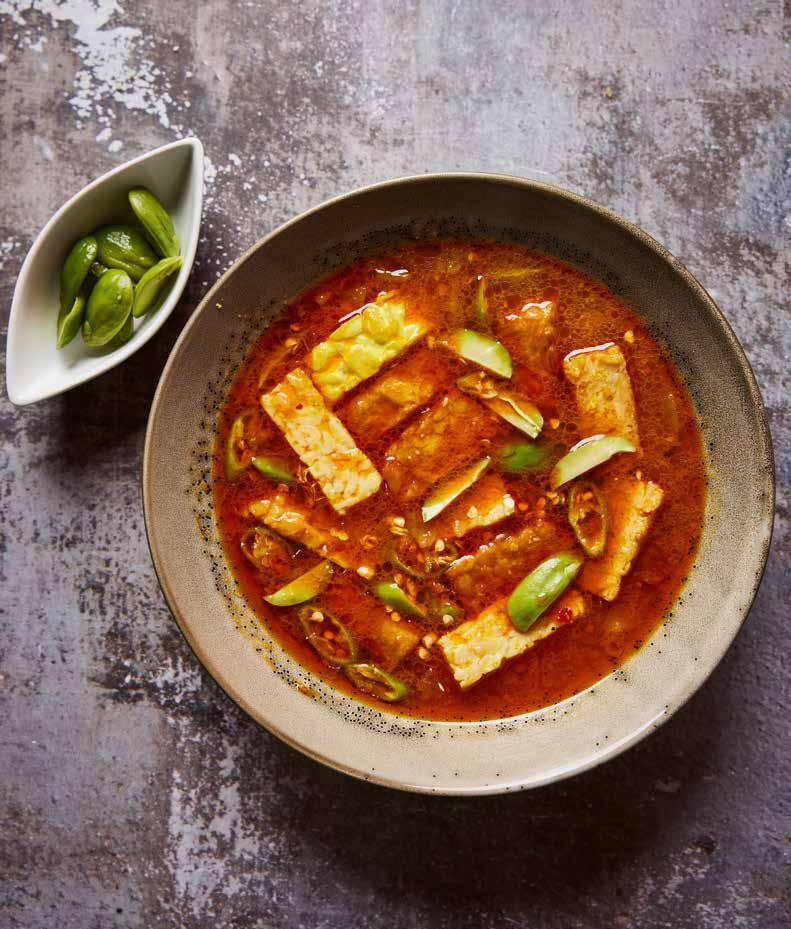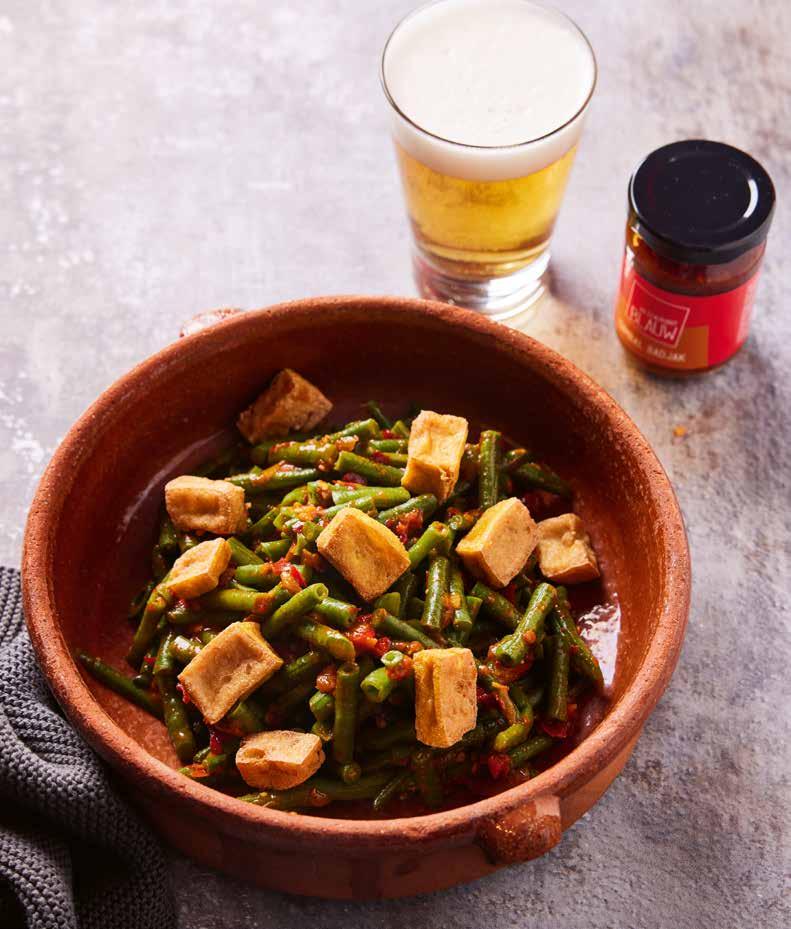BLAUW’S VEGGIE KITCHEN
Restaurant Blauw’s Crew Presents
70 Authentic Vegetarian and Vegan Recipes

Restaurant Blauw’s Crew Presents
70 Authentic Vegetarian and Vegan Recipes
In Indonesia, dining with our families is an important and cherished tradition. For me, Indonesian cuisine is synonymous with the comfort and warmth that I find with my family. I strive to convey this feeling to our guests when they dine with us, making them feel welcome and part of our extended family.
This distinctive “Blauw feeling” is the guiding principle for our entire approach to our guests and our team.
Naturally, our passion for delicious cuisine, quality ingredients, and hospitality is paramount for me and my team. The acknowledgment of our efforts by Michelin, which awarded us the 2022 Bib Gourmand, has certainly reinforced our dedication to our values.
My deep love and passion for Indonesian cuisine was cultivated from an early age. My father spent part of his youth in the former Dutch East Indies (now Indonesia) before coming to the Netherlands at the age of thirteen. At home we frequently cooked Indonesian dishes. As a child, I would help my father to prepare the rijsttafel (“rice table”), a feast of many small dishes reserved for special occasions.
I come from a hardworking, entrepreneurial family,
and when I entered the hospitality industry at the age of seventeen I joined their ranks. My journey took me through many areas of this sector, including luxury dining and Michelin-starred restaurants, which reinforced my deep respect for top-notch service and exceptional food. When as a consultant I had the opportunity to take over Restaurant Blauw Amsterdam-Utrecht, I strove to create a relaxed, informal atmosphere while still holding onto these values. That was in 2013, and I believe we have achieved this admirably.
Earlier, we used to take a photo at each table, just as we would at family gatherings. These pictures were compiled into an album on our website. Times have evolved, and now that everyone has a camera on their phone, we have discontinued this practice. However, we still often help guests capture memorable moments at Blauw with their own phone.
Both of our restaurants boast a fantastic team of employees who are dedicated to our goals. We work essentially as a family. After some challenging years and a few departures, I am pleased with the steadfast core team that remains.

When you step into Blauw, whether in Utrecht or Amsterdam, your attention is immediately drawn to a large family photograph that adorns the wall. This photograph holds special significance, and dates back over 120 years. It captures the value we place in family, and the warmth and nurturing that family can provide. In Indonesia, family is very important, and serves as the nucleus around which life revolves. At Blauw, you can see the essence of family beyond its customary meaning: people who enjoy making others happy and comfortable by preparing and serving delicious, heartwarming food. As I said, the idea of family runs deep within our team. To express the sense of belonging we feel as the
“Blauw family,” it felt natural to create a cookbook together. Each member of our team contributed their favorite recipes, which often have a special personal meaning for them. Blauw’s Veggie Kitchen is the story of our employees, who carry within them a treasury of beautiful dishes, cherished both in their memories and in their hearts. Cooking is an art born of the heart, an expression of love, affection, and comfort. Our hope is to convey this sentiment within our restaurants and through the pages of this book.
Henk van Hees, Owner of Restaurant Blauw Amsterdam-Utrecht
Indonesian cuisine is rich and diverse. This is not surprising, considering that Indonesia is made up of over 16,000 islands. Geography, climate, and religion all play a significant role in determining the dishes served. Although Indonesia is predominantly Islamic—it is the largest Islamic country in the world—about ten percent of the population is Christian, and in Bali, Hinduism is widely practiced.
Because of Hindu influences, pork is consumed in Bali but in Java it is not. While pigs are raised in Java, they are less prevalent in the street scene. Chinese immigrants who settled in Indonesia have access to pork. However, for the majority of Indonesia’s Islamic population, pork is not a part of the menu. The province of Aceh on the island of Sumatra maintains the most traditional approach. Although there are numerous cultural and political sensitivities, Indonesians tend to avoid discussing these issues, a characteristic often observed in Asian culture: conflict avoidance. This trait is mirrored in their culinary culture, which is incredibly diverse.
It would be inaccurate to claim that Indonesian cuisine is exclusively spicy, because the spiciness varies across regions. Due to the influence of Indian cuisine, West Sumatra features many curry-like dishes and tends to be spicy. Javanese dishes are milder and sweeter, particularly in Central Java. North Sulawesi (also called Noord-Celebes in the Netherlands) is known for its seafood, with dishes that are brightly flavored, wellseasoned, and spicy. Bali is known for dishes that make abundant use of vegetables and pork.
The Dutch who lived in Indonesia before the revolution were located primarily in Jakarta, Java. This is why the Dutch are familiar with less spicy cuisine. The use of sambal (a spicy condiment) alongside meals is typically Dutch. In Indonesia, sambal is added to food during preparation as a flavoring. Since this resulted in meals that were too spicy for many Dutch people, sambal began to be served on the side. Whether people consume primarily plant-based food depends on the region they live in. In Bandung, for
instance, vegetables are a staple due to the city’s geographical features: lush greenery, fertile soil, and a climate suitable for growing vegetables. Java utilizes over fifty percent of its land for rice paddies (sawahs). Generally, rice is grown in the valleys and on the plains. Meat consumption in Indonesia depends largely on one’s financial means. Some people eat only rice with sambal, while others add vegetables and maybe eggs. Those with higher incomes include meat, fish, or poultry in their daily meals. Geography also determines the menu: coastal towns favor fish, while inland areas focus on meat and poultry. Because there is a risk of spoilage when transporting harvested fish in a warm climate, fish are transported alive and slaughtered at the destination. The beloved dish known as rendang—beef stewed in spicy coconut sauce—can have a dry or wetter form, based on the region. Surveys show that rendang and nasi goreng (fried rice) are the most widely consumed
Indonesian dishes worldwide. Rendang is to Indonesia as split pea soup is to the Netherlands. Each recipe in Indonesian cuisine has a unique preparation method, and each chef adds their own special twist. A recipe is a guideline. Suppose that the recipe calls for ten peppers, but one pepper is hotter than the others. During preparation, cooks will smell and taste a dish to see whether there should be more or less of a certain flavor, and then make adjustments according to taste. Introducing variations to a recipe, personally interpreting and tailoring a dish, is how diversity in culinary cultures is born. The same principle applies to the presentation of dishes. In this book we sometimes recommend adding garnishes, like an edible flower or a few lemongrass rings, to make a dish more visually appealing. Of course, these garnishes are optional and do not determine the taste. Have fun, and unleash your creativity when presenting your dishes!

Hendra is the executive chef at both Blauw restaurants. This means he is in charge of the daily operations, manages the kitchen, develops recipes, and creates menus such as the rice tables. Initially, the menus of the restaurants differed slightly, but now both restaurants have the same menu. The emphasis is on authentic Indonesian cuisine. “In Indonesia, people eat rice with one or just a few dishes. However, during celebrations the table is filled with dishes, and that’s when you have an XXL rice table.”
Whenever Hendra talks about Indonesia or Restaurant Blauw, his eyes light up and he gets a smile on his face. It’s clear where his heart and passion lie.
Hendra hails from Jakarta and speaks the dialect from there, which is different from Bahasa Indonesia. He mentions that as a child, like most other children, he gradually learned to adapt to spicy food. “Bit by bit, the food became spicier, and you get used to it.”
In the Blauw kitchen, there are Indonesians as well as people from other countries like Thailand, Eritrea, and the Netherlands. “Indonesians speak Indonesian among themselves, but when others are present, we switch to Dutch or English. It’s important to me that no one feels excluded,” Hendra says. “We’re one team, with one goal: to prepare the most delicious food. A sense of family among the staff makes it easier to achieve that goal.”
YOU CAN FIND HENDRA’S RECIPES ON PAGES 73, 89, 91, 93, 133 AND 201.

Sayur asem is a tangy vegetarian vegetable soup flavored with tamarind. While our first restaurant cookbook (“Blauw: Authentic Indonesian Dishes,” in Dutch) also includes a recipe for this beloved soup, this version offers a different yet equally delicious take on it.
MULFI YASIR
1½ liters water
2 ears of sweet corn
100 g yard-long beans
100 g Chinese cabbage or white cabbage
1 chayote (labu siam)
1 red bell pepper
50 g unsalted peanuts, finely chopped SAUCE
3 candlenuts (kemiri nuts)
4 garlic cloves, peeled
3 red Spanish chili peppers (lombok), chopped
3 Indonesian bay leaves (salam leaves)
3 cm fresh galangal (laos), peeled and sliced
200 ml tamarind water
2 teaspoons salt
25 g palm sugar (gula djawa)

1. Start by bringing the water to a boil in a large soup pot.
2. Meanwhile, roast the candlenuts in a dry frying pan for 1 to 2 minutes.
3. Grind the candlenuts, garlic, and chopped chilies into a bumbu (spice paste) using a food processor or mortar and pestle. Add this bumbu to the boiling water along with the other sauce ingredients. Stir well, reduce the heat, and simmer gently while you prepare the vegetables.
4. Cut the kernels from the corn cobs with a sharp knife, add them to the broth, and let them cook for 5 minutes.
5. Trim the ends of the yard-long beans and cut the pods into 3-cm pieces. Slice the cabbage into thin strips and dice the chayote into 1 x 1-cm cubes. Remove the seeds from the bell pepper and slice it into strips. Add these prepared vegetables to the tamarind broth. Allow to simmer gently for another 3 to 5 minutes.
6. Finally, ladle the soup into bowls or serving dishes and garnish with the chopped peanuts.

Jackfruit in a spiced sauce
Jackfruit is well-suited for using in vegetarian cuisine. Its texture resembles meat, and its neutral flavor readily absorbs other flavors.

3 tablespoons oil
1 onion, peeled and chopped
2 garlic cloves, finely chopped
1 lemongrass (sereh) stalk, cut into quarters and bruised
1 tablespoon sambal oelek
1 turmeric leaf (kunyit leaf), sliced
200 ml water
2 tablespoons tamarind water
600 g young jackfruit (nangka), cut into smaller pieces if desired freshly ground pepper and salt
BUMBU
3 red Spanish chili peppers (lombok), chopped
3 bird’s eye chilies (rawit), chopped
½ red bell pepper, chopped
5 cm fresh ginger, peeled and chopped
5 cm fresh turmeric, peeled and chopped
5 cm fresh galangal (laos), peeled and chopped
3 candlenuts (kemiri nuts), chopped
½ teaspoon salt
1. Grind all of the ingredients for the bumbu into a smooth paste using a food processor.
2. Heat the oil in a wok and sauté the onion and garlic for 2 minutes. Add the bumbu and stir-fry for another 3 minutes.
3. Add the lemongrass, sambal oelek, and turmeric leaf to the bumbu mixture in the pan and pour in the water. Stir well and let the sauce simmer gently for 10 minutes. Add a little extra water if necessary; the sauce should have the consistency of soup.
4. Stir in the tamarind water and add the jackfruit. Simmer over low heat for another 10 to 15 minutes.
5. Season with pepper and salt.

Zucchini cut into ribbons can be prepared like noodles.

2 zucchinis
2 to 3 tablespoons oil
6 makrut lime leaves (djeruk purut)
2 tablespoons vegetable broth
soy sauce pepper and salt
1 tablespoon finely chopped parsley
2 spring onions (scallions), sliced
1 egg per person, boiled or fried (optional, for a vegetarian version)
BUMBU
2 onions, peeled and coarsely chopped
8 garlic cloves, peeled
4 red Spanish chili peppers (lombok), chopped
100 g fresh ginger, peeled and chopped
ADDITIONAL EQUIPMENT spiralizer
1. Grind the ingredients for the bumbu into a paste using a food processor or mortar and pestle.
2. Using a spiralizer, cut the zucchini into noodle-like ribbons.
3. Heat the oil in a wok and sauté the bumbu, stirring constantly.
4. After 3 minutes, add the zucchini and makrut lime leaves. Stir-fry for 2 minutes.
5. Season with the vegetable broth, soy sauce, pepper, and salt.
6. Turn off the heat and garnish with the parsley and spring onions. If you like you can also add two slices of grilled zucchini.
7. Serve the “noodles” with boiled or fried eggs, if desired.

This dish of stir-fried noodles is prepared slightly differently in every family. But all of these different versions have one thing in common: they’re always tasty.
YUNITA DIRMAYANTI

200 g rice vermicelli
4 tablespoons sweet soy sauce (kecap manis)
3 tablespoons oil
2 eggs
6 garlic cloves, finely chopped
1 medium carrot, coarsely grated
50 g Chinese cabbage, thinly sliced freshly ground white pepper and salt
1 teaspoon sugar
2 spring onions (scallions), sliced (including the green part)
½ tablespoon finely chopped celery leaves
1. Prepare the rice vermicelli according to the package instructions. Drain, then mix in the sweet soy sauce and set aside.
2. Heat the oil in a wok. Beat the eggs, add them to the wok, and stir-fry to scramble. Add the garlic and stir-fry.
3. Add the carrot and stir-fry for 1 minute. Add the Chinese cabbage and stir-fry for another 2 minutes.
4. Add the rice vermicelli, pepper and salt, and sugar, and stir well. Mix in the spring onions and turn off the heat. Garnish with the chopped celery leaves.

Petai beans, also known as bitter beans, can be roasted in their pods and then peeled. Here, though, we cut the beans into strips and sauté them in oil.

3 tablespoons oil
200 g tempeh, cut into 1 x 3-cm strips
1 green Spanish chili pepper (lombok), sliced
50 g petai beans (bitter beans), sliced
1 teaspoon sambal oelek
200 ml water
200 ml coconut milk
pepper and salt
1 spring onion (scallion), sliced
BUMBU
1 onion, peeled and chopped
2 garlic cloves, peeled
1 tomato, chopped
vegetable bouillon powder, to taste
1. Grind the ingredients for the bumbu into a smooth paste using a food processor or mortar and pestle.
2. Heat the oil in a heavy-bottomed pan and sauté the bumbu for 5 minutes, stirring constantly.
3. Add the tempeh strips and sauté for 3 to 5 minutes until brown.
4. Add the green chili, petai beans, and sambal oelek and sauté for 1 minute. Pour in the water, stir, and bring to a boil. Simmer for 5 minutes.
5. Add the coconut milk, heat briefly, and season with pepper and salt.
6. Garnish with the spring onion.

“Oseng” refers to stir-frying, a cooking technique commonly used in Indonesian cooking. The word that follows indicates the stir-fried ingredient (or one of the stir-fried ingredients), in this case, tempeh.
VERA ATIKA
150 ml oil
400 g tempeh, cut into 2 x 2-cm cubes
180 g onions, finely chopped
40 g garlic, thinly sliced
5 red Spanish chili peppers (lombok), thinly sliced
1 beefsteak tomato, diced
3 makrut lime leaves (djeruk purut)
4 generous tablespoons sweet
soy sauce (kecap manis)
1 teaspoon salt
5 teaspoons sugar

1. Heat 100 ml of the oil in a frying pan. Fry the tempeh cubes until they are golden brown and crispy. Remove from the pan and set aside.
2. Heat the remaining oil in the pan and sauté the onions, garlic, red chilies, tomato, and makrut lime leaves over high heat for 5 minutes, stirring constantly. Reduce the heat after 5 minutes, add the tempeh, and stir to combine.
3. Add the sweet soy sauce, salt, and sugar, stir, and simmer for another 4 to 5 minutes.

Pan-fried eggplant in a delightful honey sauce

2 eggplants, cut into 2 x 2-cm cubes salt
1 egg
2 to 3 tablespoons flour
3 tablespoons oil
1½ tablespoons honey
1½ tablespoons tomato ketchup
5 tablespoons soy sauce (kecap asin)
1 tablespoon sesame oil
2 tablespoons toasted sesame seeds
1. Place the eggplant cubes in a sieve over a bowl. Sprinkle the cubes generously with salt and let them sit for 15 minutes. Drain off the released liquid and pat the cubes dry.
2. Beat the egg in a large bowl and mix in the eggplant cubes, making sure all of the cubes are well coated with egg.
3. Sprinkle the flour over the eggplant and shake well to coat all of the cubes with flour.
4. Heat the oil in a wok and fry the eggplant cubes until golden brown. Remove the cubes from the pan and set aside.
5. Put the honey, tomato ketchup, soy sauce, and sesame oil in the wok and heat while stirring to make a sauce. Add the eggplant cubes and toss to combine. Garnish with the sesame seeds.

These tofu balls are deliciously crispy.

300 g tofu
2 spring onions (scallions)
2 sprigs of celery leaves
3 shallots, peeled
1 tablespoon oil
1 egg
½ teaspoon garlic powder
¼ teaspoon ground or grated nutmeg
3 tablespoons flour
1 tablespoon rice flour
1 teaspoon salt
1 teaspoon sugar
1 teaspoon ground white pepper
½ vegetable bouillon cube or ½ tablespoon vegetable bouillon powder
500 ml oil for deep-frying
1. Squeeze out as much moisture as possible from the tofu. Finely mash the tofu with a fork.
2. Finely chop the spring onions, celery leaves, and shallots.
3. Heat the 1 tablespoon of oil in a small pan and sauté the spring onions, celery leaves, and shallots for 2 to 3 minutes, stirring constantly.
4. Combine the tofu with the sautéed spring onion, celery leaf, and shallot mixture and the remaining ingredients (except the oil for deep-frying). Stir well.
5. Form the mixture into balls the size of an unshelled walnut. Flatten them slightly with your hands. Continue until all of the mixture has been used.
6. Heat the oil for deep-frying to 160°C in a deep pan. Fry the tofu balls in the hot oil in batches until golden brown, about 4 to 6 minutes. Turn the balls while frying.
7. Remove from the pan and drain on paper towels.

This classic sambal goreng buncis is no longer on the menu at Blauw, but we’re bringing it back (and into your home) through this book.
oil for frying
1 onion, peeled and chopped
2 garlic cloves, finely chopped
½ lemongrass (sereh) stalk, cut into pieces and bruised
2 makrut lime leaves (djeruk purut)
500 g green beans
125 g tofu, cut into 1 x 1-cm cubes salt
½ red Spanish chili pepper (lombok), sliced
100 ml water
25 g creamed coconut (from a block)
BUMBU
4 candlenuts (kemiri nuts)
3 cm fresh ginger, peeled and chopped
3 cm fresh galangal (laos), peeled and chopped
3 makrut lime leaves (djeruk purut), center rib removed
½ red bell pepper, chopped
½ lemongrass (sereh) stalk, just the white part, finely chopped
½ teaspoon salt
1 teaspoon ground white pepper
2 teaspoons sambal oelek
2 tablespoons oil
1. Start by making the bumbu. Roast the candlenuts in a dry skillet and coarsely chop.
2. Grind the candlenuts and the rest of the bumbu ingredients into a smooth paste using a food processor.
3. Heat 2 to 3 tablespoons of the oil for frying in a wok and sauté the onion and garlic for 3 minutes. Add the bumbu, lemongrass, and makrut lime leaves, and stir-fry for 15 minutes, stirring regularly. If it starts to stick, add a little water or oil.
4. Clean the green beans and cut them into 4-cm pieces.
5. Heat 2 more tablespoons of oil in a frying pan and sauté the tofu cubes, stirring, until golden brown. Remove from the pan, drain on paper towels, and sprinkle lightly with salt.
6. Remove the lemongrass and makrut lime leaves from the wok with the fried bumbu. Add the green beans, red chili, and water, then stir and bring to a boil. Simmer for 5 minutes until the beans are al dente.
7. Add the creamed coconut and let it melt.
8. Serve the sambal buncis on a platter, topped with the fried tofu.

There’s a reason this tasty, spicy side dish is a classic.
100 ml oil, plus 2 tablespoons extra
100 g tempeh, cut into 1 x 1-cm cubes
½ onion, peeled and chopped
1 garlic clove, finely chopped
1 tomato, diced
3 red Spanish chili peppers (lombok), sliced
½ teaspoon salt
1. Heat the 100 ml of oil in a frying pan and stir-fry the tempeh cubes until golden brown. Remove them from the pan and set aside.
2. In a mortar and pestle, combine the onion, garlic, tomato, red chilies, salt, and the 2 tablespoons of oil and grind into a paste.
3. Add the fried tempeh cubes and gently crush the cubes, taking care that it doesn’t get mushy.

Spicy salad with tofu and various kinds of mushrooms
What’s wonderful about this salad is that it contains three different types of mushrooms.
UMA PHETKAW

500 ml water
500 g tofu, cut into four slices rice oil for frying
200 g oyster mushrooms, torn into pieces
150 g king oyster mushrooms, sliced
150 g shiitake mushrooms, sliced
1 shallot, peeled
10 g mint leaves, shredded
15 g cilantro, coarsely chopped
1 spring onion (scallion), sliced
30 g roasted rice powder*
DRESSING
1 teaspoon chili powder
1 teaspoon ground galangal (laos)
2 tablespoons light soy sauce
15 g sugar
½ teaspoon salt
1. Bring the water to a boil in a pan, add the tofu slices, and cook for 5 minutes. Remove the tofu from the pan and pat the slices dry with paper towels.
2. Heat 2 tablespoons of rice oil in a pan and brown the tofu on both sides.
3. Remove the tofu from the pan and mash it with a fork.
4. Heat another 2 tablespoons of rice oil and sauté the mushrooms in batches until browned. Add extra oil if necessary.
5. Mix all of the ingredients for the dressing in a small bowl.
6. Combine the tofu, mushrooms, shallot, mint, cilantro, spring onion, and roasted rice powder in another bowl. Gently mix in the dressing.
7. Serve with cucumber, fresh vegetables, and white rice.
* To make rice powder: Roast 50 grams uncooked rice in a dry frying pan until golden brown; move the pan regularly to keep the rice from burning. Allow the rice to cool, then grind it into a fine powder using a mortar and pestle.